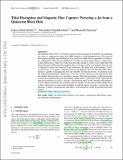| dc.contributor.author | Kelley, L. Z. | |
| dc.contributor.author | Tchekhovskoy, A. | |
| dc.contributor.author | Narayan, Ramesh | |
| dc.date.accessioned | 2016-08-03T20:03:01Z | |
| dc.date.issued | 2014 | |
| dc.identifier.citation | Kelley, L. Z., A. Tchekhovskoy, and R. Narayan. 2014. “Tidal Disruption and Magnetic Flux Capture: Powering a Jet from a Quiescent Black Hole.” Monthly Notices of the Royal Astronomical Society 445 (4) (October 31): 3919–3938. doi:10.1093/mnras/stu2041. | en_US |
| dc.identifier.issn | 0035-8711 | en_US |
| dc.identifier.uri | http://nrs.harvard.edu/urn-3:HUL.InstRepos:27801833 | |
| dc.description.abstract | The transient Swift J1644+57 is believed to have been produced by an unlucky star wandering too close to a supermassive black hole (BH) leading to a tidal disruption event. This unusual flare displayed highly super-Eddington X-ray emission which likely originated in a relativistic, collimated jet. This presents challenges to modern accretion and jet theory as upper limits of prior BH activity, which we obtain from the radio afterglow of this event, imply that both the pre-disruption BH and stellar magnetic fluxes fall many orders of magnitude short of what is required to power the observed X-ray luminosity. We argue that a pre-existing, “fossil” accretion disc can contain a sufficient reservoir of magnetic flux and that the stellar debris stream is capable of dragging this flux into the BH. To demonstrate this, we perform local, 3D magnetohydrodynamic simulations of the disc–stream interaction and demonstrate that the interface between the two is unstable to mixing. This mixing entrains a sufficient amount of fossil disc magnetic flux into the infalling stellar debris to power the jet. We argue that the interaction with the fossil disc can have a pronounced effect on the structure and dynamics of mass fallback and likely the resulting transient. Finally, we describe possible ramifications of these interactions on unresolved problems in tidal disruption dynamics, in particular, the efficiency of debris circularization, and effects of the disruption on the preexisting black hole system.
Animations online: http://goo.gl/T84tLs | en_US |
| dc.description.sponsorship | Astronomy | en_US |
| dc.language.iso | en_US | en_US |
| dc.publisher | Oxford University Press (OUP) | en_US |
| dc.relation.isversionof | doi:10.1093/mnras/stu2041 | en_US |
| dc.relation.hasversion | https://arxiv.org/abs/1410.0366 | en_US |
| dash.license | OAP | |
| dc.subject | MHD | en_US |
| dc.subject | stars:black holes | en_US |
| dc.subject | galaxies: jets | en_US |
| dc.subject | quasars: supermassive black holes | en_US |
| dc.subject | galaxies: kinematics and dynamics | en_US |
| dc.title | Tidal disruption and magnetic flux capture: powering a jet from a quiescent black hole | en_US |
| dc.type | Journal Article | en_US |
| dc.description.version | Accepted Manuscript | en_US |
| dc.relation.journal | Monthly Notices of the Royal Astronomical Society | en_US |
| dash.depositing.author | Narayan, Ramesh | |
| dc.date.available | 2016-08-03T20:03:01Z | |
| dc.identifier.doi | 10.1093/mnras/stu2041 | * |
| dash.contributor.affiliated | Narayan, Ramesh | |


